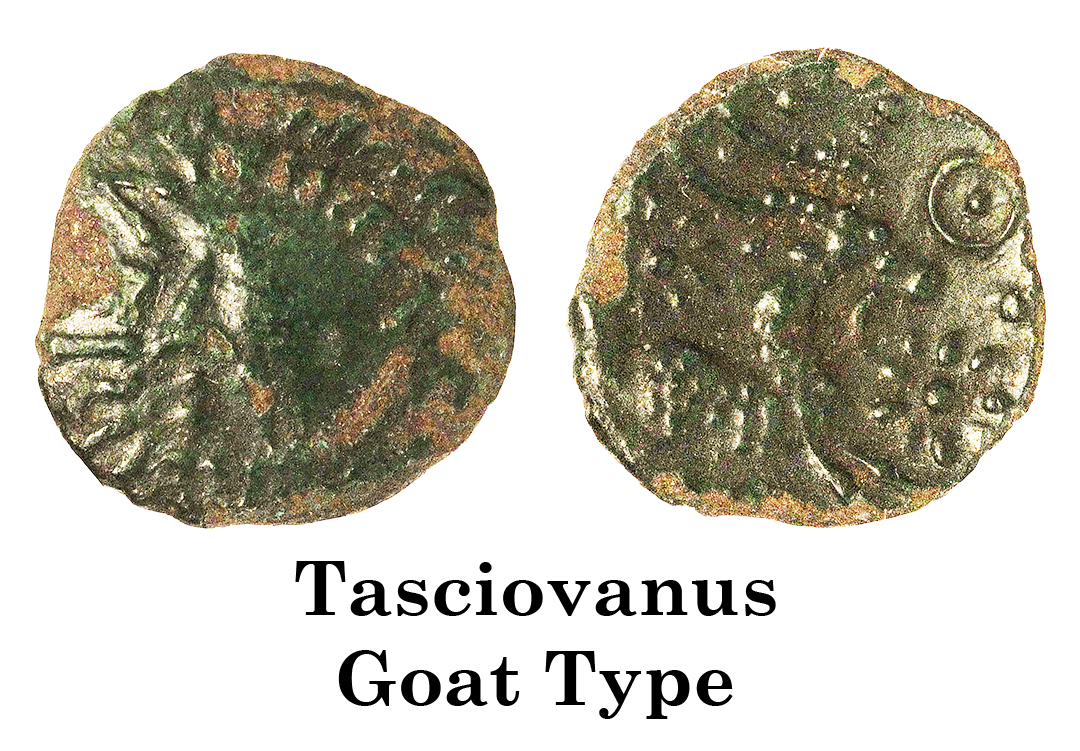
Numismatic Articles
Van Arsdell 2020a (Info)
Semiotics of Celtic Coins XVI – Do Borrowed Images Mean Borrowed Messages?
by Robert Van Arsdell
Introduction
Numismatists knew 400 years ago that some of the images seen on Celtic coins were inspired by Roman prototypes. (Info) The search for these sources on Roman denarii was well underway by the 1850s. (Info) Within the last 65 years, the search has expanded to include other ancient coin types, scenes from British life and engraved gemstones. (Info) Controversially, Creighton has suggested that direct contact between Ancient British and Roman rulers may have played a role in the choice of imagery. (Info)
Pointing out the sources of inspiration, however, only gets us part way to understanding the meaning. There's much more to do before we can understand the messages from the British rulers.
Roman coins as prototypes – does a borrowed image say something or is it just a decoration?
So many British coins contain borrowed imagery that we might suspect the phenomenon has a semiotic component. The key is to assess the way the rulers used borrowed images on a case by case basis. We first need to judge whether the ruler could have understood the Roman meaning of a borrowed image. We then need to determine whether the intent was to send that same message, or create a new one. If we can do this in a plausible way, the Roman prototype might tell us something about that message.
Looking at this in detail, one can suggest several possibilities:
- The borrowed image is a decoration and has no meaning
- The ruler did not understand the Roman meaning, but borrowed the image and gave it a new Code
- The ruler understood the meaning of the Roman image, but has re-coded it to convey a different meaning
- The ruler understood the meaning of the Roman image and intended to convey a similar meaning
The first alternative (it's only a decoration) says there was no semiosis involved in selecting the image, and further analysis would be fruitless. The borrowed image is just used to make the coin more attractive to viewers. Choosing this alternative should be seen as taking the easy way out, because choosing one of the others prompts a lot of work. Nevertheless, a borrowed image means someone was familiar with the prototype and we must consider whether something semiotic was intended. The first alternative should be considered the least likely one, not the preferred one.
The order of other alternatives suggests semiosis involving increasing Romanization in Britain. In number 2, neither the ruler nor the British people knew what the Roman imagery meant. In number 3, the ruler knew the Roman meaning, but the British population would not have. In number 4, the British population was sufficiently familiar with Roman culture that the ruler could use a Roman image and know the people would understand it.
The Semiotics
For the first alternative, the interplay of semiotics, decoration and artistry has been discussed in a previous article, and needs no further discussion here. (Info) The other three alternatives may be analyzed using Umberto Eco's mapping of Moderate Inventions. (Info)
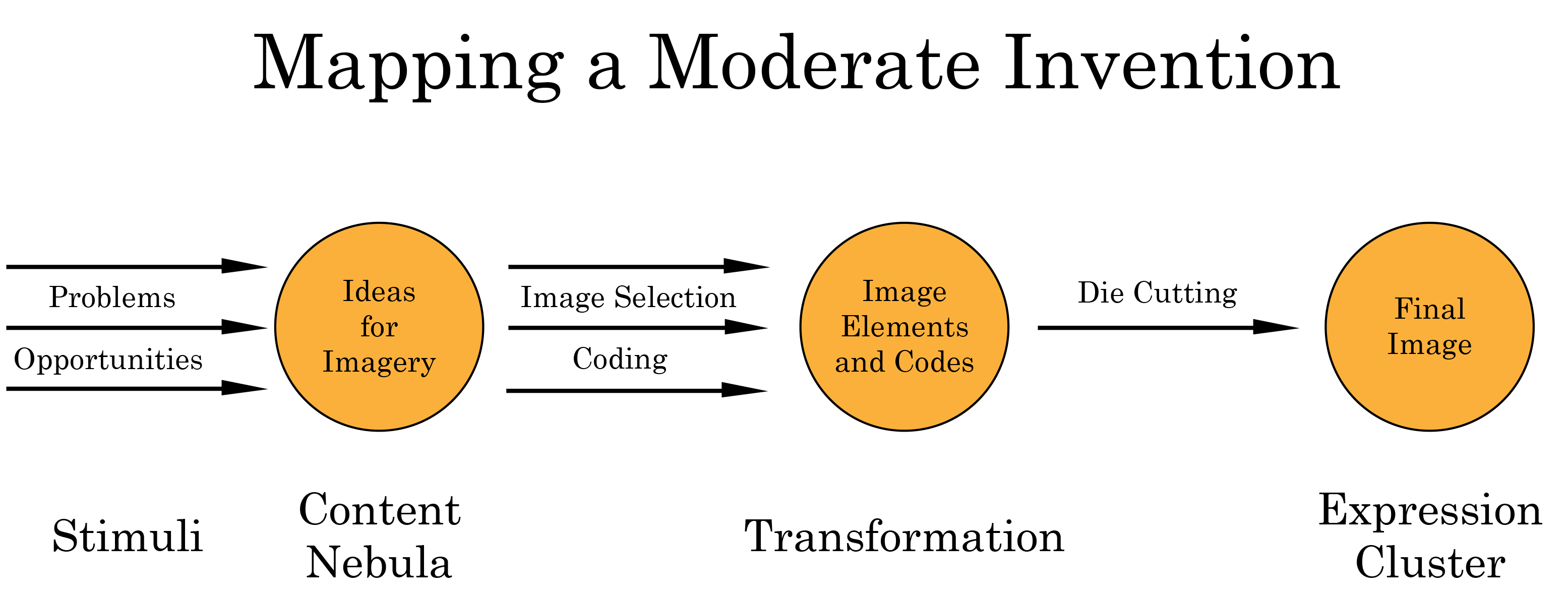
The semiotic analysis is straightforward:
Step 1:
The Roman image and its meaning are two separate Stimuli the ruler might have received. (Info) These, combined with other Stimuli should produce a Content Nebula with plausible ideas for action. Thus, the elaboration of the Content Nebula is the place where the claim of a prototype should be justified. The claim for image-borrowing becomes stronger as the British and Roman images approach a visual match. Finds of the Roman coin in the British archaeological record for the time of the ruler would add further support.
Whether or not the ruler knew the Roman Code would be the other Stimulus. The claim that the ruler may have known the Code becomes stronger when the Roman coin was struck closer to the time of the British one. It also becomes stronger when the British ruler may have known about the events that prompted the Roman imagery. (Info)
Step 2:
In the Transformation, the use of the imagery would be assessed with regard to solving the problems in the Content Nebula. Does including the borrowed image send the right message, or does the image need a new Code? If the image is given a new Code, does it get the job done?
Step 3
In the Expression Cluster, does the inclusion of the Roman image work with the other image elements to present a coherent set of Denotations and Connotations? Finally, does the set of Denotations and Connotations solve the problems in the Content nebula?
I will now give an example to show how this is done. I've chosen a plausible example of a prototype, but it's by no means proven. The point of the exercise is to describe the semiotic analysis, not to make a case for its outcome. Thus, I've chosen a merely plausible prototype and ask readers to accept it on admittedly slight evidence. This will enable us to concentrate on the semiotic analysis, instead.
Tasciovanus Goat Type

The Tasciovanus Goat Type was first found during excavations at Chesterford in 1847 and was promptly published by Neville. C. Roach Smith immediately suggested the goat on the reverse was copied from a Roman coin, but offered no prototype. (Info) Neither Evans, Mack, nor Hobbs mentioned a Roman source for the goat image. (Info) Scheers noted that goats appear on Greek coins of the fifth to first centuries BC during her lecture in 1989. However, she said that many of her suggestions were unlikely, and that she was only suggesting the range of possibilities available to workers. (Info)
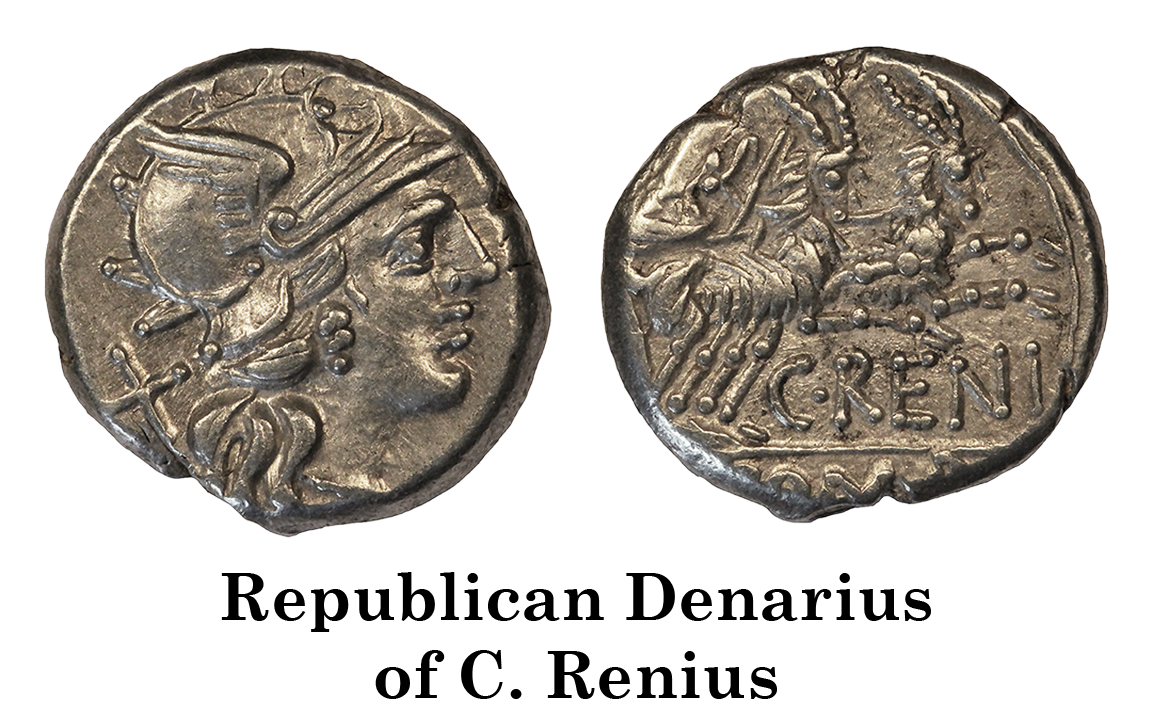
A more likely source of the goat may be the goat biga on the denarii of C. Renius. (Info) The British goat isn't the same as the Roman one, but it's a plausible adaptation of it. The chariot portion of the image if off the flan on many examples of the denarius, so it's possible the British die cutter didn't know of its existence. The fact that the Roman coin would have been a hundred years old when it was copied needn't be a problem – Republican denarii stayed in circulation for long periods. Reports of two of these coins in the Portable Antiquities Scheme database support the idea the type was known in Britain. (Info) We'll accept the prototype as plausible and move on to the semiotic analysis.
Step 1
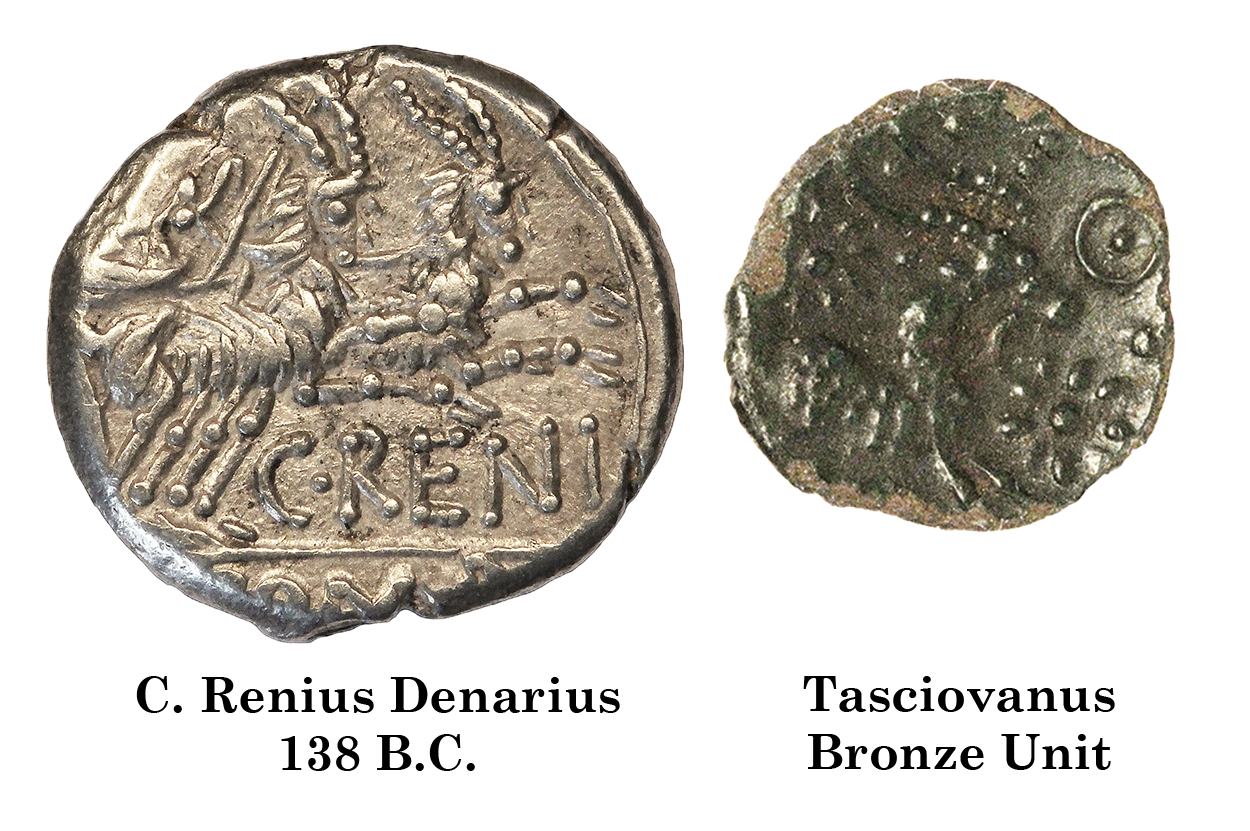
Having identifed the Renius denarius as a Stimulus, the next thing would be to list all the other Stimuli. We would determine if the British ruler or the British public knew what the image meant – did anybody know the Roman Code? After a lapse of a hundred years, it's unlikely anyone in Britain was familiar with the Code of the goat biga. The ruler (or a die-cutter) had the old coin, but probably had no idea of the meaning. It's more likely the ruler liked the image, copied it and gave it a new Code to suit the situation at hand. Thus, the Roman imagery was one of the Stimuli received by the ruler, but the Code was not. We should anticipate the Content Nebula was influenced by other Stimuli and the ruler faced additional opportunities and problems. For example, the ruler may have faced opposition from malcontents amongst the population and needed to do something about it. (Info)
Taken all together, we have:
The Stimuli
- Tasciovanus is a new ruler (the goat type is part of Tasciovanus' First Coinage)
- Possible discontent amongst the population
- Possibility that the agricultural/pastoral elites are involved
- Possibility of being deposed
- Knowledge of the role of animals in Celtic religion
- Availability of an attractive Roman image to borrow
- No idea what the Roman image means
- Low-value coins already in circulation (a means of spreading messages)
The Content Nebula
- Need to consolidate power
- Need to quell opposition
- Need to appeal to the population for continued support
- Possibility of using a Roman image to appeal to a key group (agricultural/pastoral elites)
- Possibility of using a Roman image to appeal to others in society who support the agricultural/pastoral elites
- Ability to use a low-value coinage to reach both the elites and non-elites with the appeal
- Ability to use the Roman image in a way that resonates with the British population
Step 2
In the second step of the analysis (in the Transformation), the ruler chose the goat as part of the coin's imagery. However, the image was given a new Code to send a new message. The ruler would have been reacting to a specifically British situation.
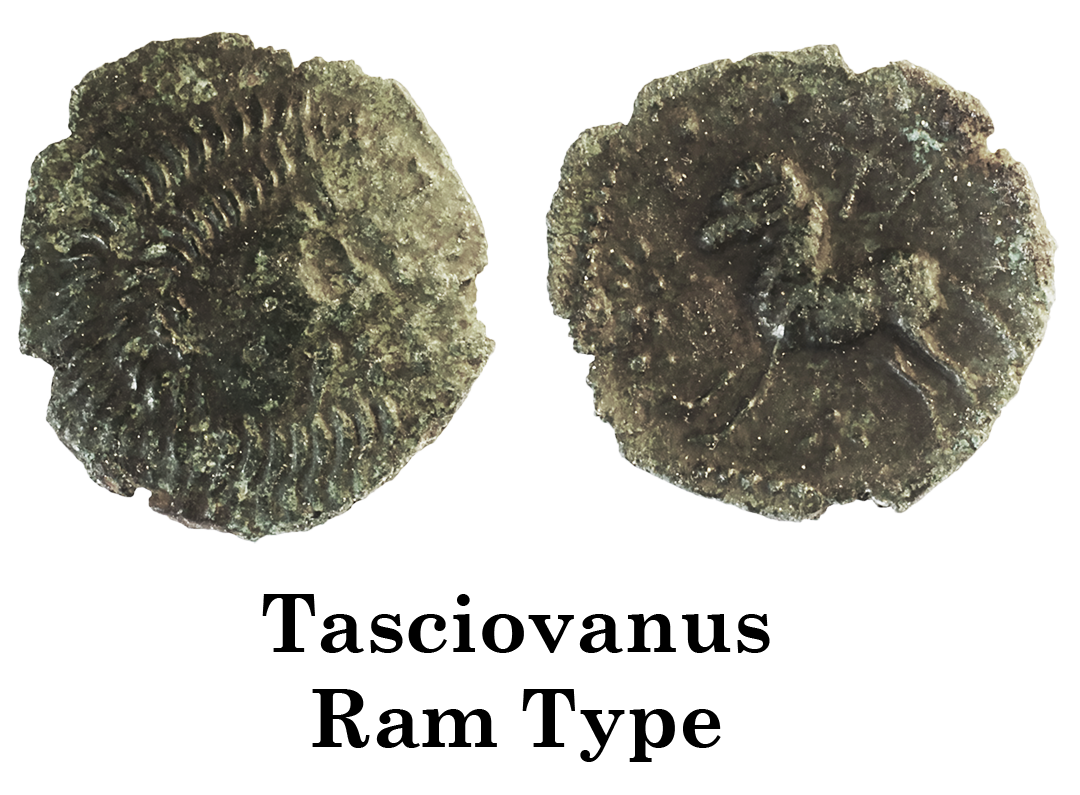
Looking further, there is another image that could offer insight into the Transformation. The Ram Type of Tasciovanus has always been considered a relation of the Goat Type. (Info) The goat and the ram may have offered a solution to the the public discontent. Using pastoral images might mollify the agricultural/pastoral elites and convince them Tasciovanus was an ally. Thus, in the Transformation, Tasciovanus selected images with Codes such as "promoting the wealth of the realm" or perhaps "appealing to the gods to protect the animals". Tasciovanus would have appealed to the agricultural/pastoral elites as an effective ruler by promoting his competence in fostering pastoralism, or perhaps by invoking the gods to do it. (Info)
Some items in the Transformation might be:
- Identify the ruler via an image of a man and the name of the seat of power
- Use images of animals to draw the attention of the agricultural/pastoral elites
- The images indicate the the ruler is actively supporting those elites
An alternative Transformation might be:
- Identify the ruler via an image of a man and the name of the seat of power
- Use images of animals to draw the attention of the agricultural/pastoral elites
- The images indicate the the ruler is invoking the gods to protect those elites
The Expression Cluster becomes:
- Obverse: man's head (ruler) and VER (seat of power)
- Reverse: Goat
Step 3
The Denotations and Connotations for the image would be:
- First Denotation (obverse): ruler in Verulamium
- First Connotation (obverse): Tasciovanus
- First Denotation (reverse): goat
- First Connotation (reverse): valuable or sacred animal
- Second Denotation: ruler, animal and elites in harmony (using an Amalmagation Switch involving the obverse and reverse imagery) (Info)
- Second Connotation: ruler supports (or invokes gods to protect) the interests of the elites
- Third Denotation: worthy and effective leader
- Third Connotation: leader deserves support of elites
The final task is to see if the Transformation and Expression Cluster (the coin imagery) solve the problems in the Content Nebula. The message that the ruler is supporting and protecting the interest of the agricultural/pastoral elites by invoking the gods (or some such action) ought to persuade the elites the ruler is a friend and not an enemy.
Whether or not those elites actually believe the message is another matter entirely. If they accept the message, it should make Tasciovanus a more secure ruler. The reactions of the elites and the actions they will take will be non-semiotic Extensions into the Continuum the ruler cannot predict. (Info)It is worth noting that Tasciovanus does not appear on the list of deposed British rulers who fled to the continent.
Summary
The basic message this coin conveys is an appeal for continued support by the ruler to a segment of the population. Such appeals fall into the category "Legitimization of Authority". They occur throughout numismatic history and are to be expected. Semiotic analysis gives us a method to judge the sophistacion of these messages.
End
